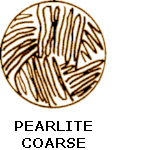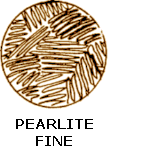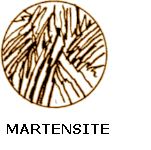Introduction
Hardness is a function of the Carbon content of the steel. Hardening of a steel requires a change in structure from the body-centered cubic structure found at room temperature to the face-centered cubic structure found in the Austenitic region. The steel is heated to Autenitic region. When suddenly quenched, the Martensite is formed. This is a very strong and brittle structure. When slowly quenched it would form Austenite and Pearlite which is a partly hard and partly soft structure. When the cooling rate is extremely slow then it would be mostly Pearlite which is extremely soft.
 |
|
 |
 |
 |
Hardenability, which is a measure of the depth of full hardness achieved, is related to the type and amount of alloying elements. Different alloys, which have the same amount of Carbon content, will achieve the same amount of maximum hardness; however, the depth of full hardness will vary with the different alloys. The reason to alloy steels is not to increase their strength, but increase their hardenability — the ease with which full hardness can be achieved throughout the material.
Usually when hot steel is quenched, most of the cooling happens at the surface, as does the hardening. This propagates into the depth of the material. Alloying helps in the hardening and by determining the right alloy one can achieve the desired properties for the particular application.
Such alloying also helps in reducing the need for a rapid quench cooling — thereby eliminate distortions and potential cracking. In addition, thick sections can be hardened fully.
Quench Media
Quenching is the act of rapidly cooling the hot steel to harden the steel.
Water: Quenching can be done by plunging the hot steel in water. The water adjacent to the hot steel vaporizes, and there is no direct contact of the water with the steel. This slows down cooling until the bubbles break and allow water contact with the hot steel. As the water contacts and boils, a great amount of heat is removed from the steel. With good agitation, bubbles can be prevented from sticking to the steel, and thereby prevent soft spots.
Water is a good rapid quenching medium, provided good agitation is done. However, water is corrosive with steel, and the rapid cooling can sometimes cause distortion or cracking.
Salt Water: Salt water is a more rapid quench medium than plain water because the bubbles are broken easily and allow for rapid cooling of the part. However, salt water is even more corrosive than plain water, and hence must be rinsed off immediately.
Oil: Oil is used when a slower cooling rate is desired. Since oil has a very high boiling point, the transition from start of Martensite formation to the finish is slow and this reduces the likelihood of cracking. Oil quenching results in fumes, spills, and sometimes a fire hazard.
Polymer quench: Polymer quenches that will produce a cooling rate in between water and oil. The cooling rate can be altered by varying the components in the mixture-as these are composed of water and some glycol polymers. Polymer quenches are capable of producing repeatable results with less corrosion than water and less of a fire hazard than oil. But, these repeatable results are possible only with constant monitoring of the chemistry.
Cryogenic Quench: Cryogenics or deep freezing is done to make sure there is no retained Austenite during quenching. The amount of Martensite formed at quenching is a function of the lowest temperature encountered. At any given temperature of quenching there is a certain amount of Martensite and the balance is untransformed Austenite. This untransformed Austenite is very brittle and can cause loss of strength or hardness, dimensional instability, or cracking.
Quenches are usually done to room temperature. Most medium carbon steels and low alloy steels undergo transformation to 100% Martensite at room temperature. However, high carbon and high alloy steels have retained Austenite at room temperature. To eliminate retained Austenite, the quench temperature has to be lowered. This is the reason to use cryogenic quenching.


